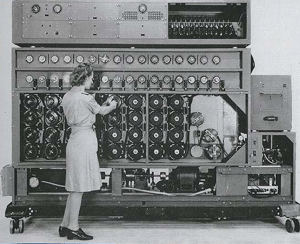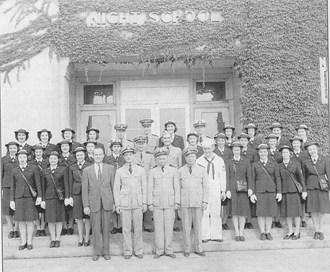How navy women working in a Dayton, Ohio computer lab helped shorten the war
By Thomas P. Copley

| WAVES operator makes adjustment to a Bombe decryption device |
In World War II, The Germans had perfected a cipher system code-named Enigma. The code was generated through the use of a series or wired rotor wheels combined with a plugboard. The internal wiring of the machine was such that the when the 26 contacts on each of several rotors were placed at the available setting positions, they produced various output contacts. The wiring connections on each rotor were different from each other. Each rotor had a movable placement notch on its outer ring which forced an adjustment in the next rotor over. By adjusting the notch on a daily basis according to a prearranged schedule the Germans were able to vary the code from day to day. The schedule also indicated which letters on the "Stecher" or plugboard linked to other letters to add yet a further layer of complication to the scheme. Finally, the code operator would select a three letter key that determined the initial rotor settings, and the key was changed with each coded transmission. The machinations resulted in a theoretical ciphering possibility of a formidable 3 X 10 to the 114th.
Using this elaborate scheme the command center in Germany was able to keep touch with its large fleet of U-boats that were waging war against the convoys coming from America to supply the UK in the Battle of Britain. The Allies were losing vast amounts of shipping, as the convoys were largely helpless against the submerged U-boats and their deadly torpedos.
The British and their American Allies decided to go after the U-boats by attacking their secret coded communications that were enabling commands passing from headquarters and coordinating the resupply of U-boats at sea. On the British side much of the research work which helped crack the German code happened at Bletchley Park in Milton Keynes, England. All of this work was naturally highly classified, and did not start to be disclosed until after 1974 almost 30 years after the war ended. Only recently did it become known that the Americans played a very heavy role in cracking the Enigma code especially as the war progressed. The Germans kept improving their code, and it was only through the intervention of the Americans working in secret at the NCR headquarters in Dayton, Ohio that the allies continued to be able to decode the "Ultra" intercepts, as the Enigma encrypted traffic was designated. There begins the story of how Navy WAVES played a "Rosie-the-Riveter"-like role in cracking this code. WAVES is an acronym for "Women Accepted for Volunteer Emergency Service" in the Navy as well as the "waves" play on words.
Because of the utmost secrecy that was involved in the work, it was compartmentalized to the n-th degree. 600 WAVES were brought into the American contractor, NCR Corporation's headquarters in Dayton, Ohio and given a very specific task to perform usually involving wiring and soldering, and ultimately to build a sufficient quantity of decryption devices to routinely break the Enigma code. Of course, if the Germans had ever realized that the Allies were quite so handy at breaking their code, they would have instantly moved on to another encryption scheme. Therefore, it was necessary to break the code, but never to disclose even the slightest hint that it had been successfully broken. WAVES were never to discuss their work with each other or their families.
WAVES were trained in soldering, reading electrical graphs, and a general electronics education. They would spend eight hours per day soldering wires. The WAVES worked around the clock with three shifts per day. Each woman was given a graph to follow, pieces of different colored wire, and soldering equipment. Since the work was so compartmentalized few suspected the real purpose of their work which was to duplicate the wiring of the Enigma machines. Even had they guessed the purpose, they would have had to keep quiet about it upon threat of being shot for treason had they ever talked.
The work was extremely tedious and tiring for the WAVES. After wiring one rotor, WAVES would immediately be given another to work on. Later many of the WAVES were transferred to the Naval Communications Annex on Nebraska Avenue in Washington, D.C. where they were allowed to know more about the full nature of their work in Dayton. However, grave secrecy was still maintained. Women in the project were lectured by a security officer "If you ever tell what you are doing, you are committing treason. And don't think that just because you are young ladies you will be treated any differently than the men who commit treason. If you ever tell, we will shoot you!"

|
WAVES standing in front of NCR Building #26, Dayton, Ohio in 1943 Photo Coutesy of NCR Photo Library |
Eventually, 121 Dayton-built decryption machines, or Bombes, as they were code named, were set up in Washington in bays of four Bombes. Each bay was operated by four WAVES operators and a supervisor. Three shifts per day were kept going in order to keep the Bombes busy at all times.
By 1944 the American were routinely breaking the U-boat messages, usually within twelve hours of the sub broadcasting it.
The WAVES work in Dayton, Ohio and Washington, D.C. was absolutely key to the secret decipherment of the U-boat transmissions back and forth with their headquarters. Most importantly, it enabled the Allies to intercept the U-boats and destroy their supply chain thus rendering the German's most formidable naval weapon almost useless.
These women sailors worked in secret and could not even share their stories until decades later, but were genuine heros who helped shorten and change the course of World War II.
Resources
Solving the Enigma:History of the Cryptanalytic Bombe
The Secret in Building 26: The Untold Story of How America Broke the Final U-boat Enigma Code
Note: The author once worked in Building 26 for NCR during the late 1970's. It was in a capacity that was completely unrelated to the building's code-breaking activities of the 1940s, and he was, at that time, blissfully ignorant of its very unique, wartime history.
Contact author:
tcopley (at) cal.berkeley.edu
Berkeley, California
March 24, 2009
License
This work is published under a Creative Commons Attribution-Noncommercial-Share Alike 3.0 License.